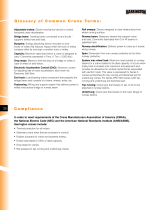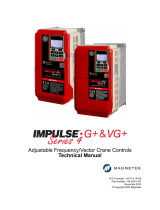
Product Application
Industrial Automation BU, Delta Electronics, Inc.
- 1 -
With solid experience and advanced technology, Delta’s IABU offers efficient and reliable solutions and service — we are your most
trustworthy partner.
COPYRIGHT © 2008 DELTA ELECTRONICS, INC. ALL RIGHTS RESERVED.
Case
Application: Delta C2000 Series AC Motor Drive and AFE2000 Active Front-End Unit for Bridge
Crane (Overhead Travelling Crane)
Issued by Solution Center Date November, 2010 Pages 5
Applicable to C2000 series AC motor drive, AFE2000 series active front-end unit
Key words
crane, hoist, Delta AC motor drive, high-level field oriented control, built-in PLC, torque control,
reliability, AFE2000 active front-end, power quality, power improvement, power factor, harmonics,
fast braking, brake resistor, current control PWM converter, switch rectifier, energy-saving
Introduction
A bridge crane (also known as an overhead travelling crane) finds wide application in warehouses, factories,
docks, open storage yards, and more. A three-phase induction motor offers many benefits including simple structure,
durability, low cost, and easy maintenance. If we employ a Delta AC motor drive to drive the induction motor rather
than using a traditional drive, the crane’s malfunction rate decreases substantially. Moreover, if Delta’s AFE2000
series active front-end unit is employed, it saves the cost of purchasing a brake resistor and excessive energy is
transformed into reusable energy through IGBT switch, which is fed back to the mains for other electronic devices.
Delta’s AC motor drive and AFE2000 is an outstanding combination for bridge cranes.
Application
The bridge crane moves back and forth with four driving and passive wheels, but when the starting load is large,
it is common to install more wheels to share the wheel load. An articulated device is needed for bridge cranes with
more than four wheels. The device’s function is to balance out the load and distribute it evenly to each wheel. The
motion is done by three independent pulling systems, as shown in [Figure 1]:
1. Trolley: To execute leftward and rightward movement along the cross-axis bridge (left/right).
2. Endtruck: To execute forward and backward movement along the long-axis runway (FWD, REV).
3. Hoist: To lift and lower the item (up/down).
[Figure 1]
The bridge crane hoist, unlike the trolley and the runway girder, has lower requirements for precision control, and
it benefits a lot from the AC motor drive. Different from traditional drives, an AC motor drive offers more thorough

Product Application
Industrial Automation BU, Delta Electronics, Inc.
- 2 -
With solid experience and advanced technology, Delta’s IABU offers efficient and reliable solutions and service — we are your most
trustworthy partner.
COPYRIGHT © 2008 DELTA ELECTRONICS, INC. ALL RIGHTS RESERVED.
safety protection and additional features such as large load inertia and 4-quadrant operation. The suggested AC
motor drive and the active front-end unit model for the bridge crane are:
VFD VFD110C23A
AFE AFE075A23A + CHOKE: 2.1mH
Application Case
System Solution
For bridge cranes, the Delta C2000 series AC motor drive has taken overload problems and long-term system
stability issues as target factors and offers excellent features such as:
1. Full vector control. Supports starting torque up to 150% rated torque at a low frequency of 1Hz in steady motion.
2. Optional braking unit is available to perform 4-quadrant operation
.
3. Constant torque at full speed range
4. With AFE2000, regenerative energy is converted by AFE2000 into reusable energy (clean power) and fed back to
the mains.
System Features
SVC control
The Delta C2000 provides sensorless vector control (SVC) to perform a nearly close-loop control function which
saves from purchasing an encoder and lowers maintenance cost. In addition, it overcomes activation difficulties, and
is capable of initiating a start-up under full load and short-term over-load conditions.
Braking process control
Prevention of sudden drops and jerky movements is an important factor in overall bridge crane system design.
The coordination between the AC motor drive and the mechanical control should be rigid to prevent sudden drops and
jerking, especially when lifting or lowering a heavy load and when stopping a heavy load in mid-air. The Delta C2000
series offers a special set of parameters and multiple output commands to promptly solve the problem.
Overload capacity
Normal load: rated output current 120%/min; Heavy load: rated output current 150%/min. This offers sufficient
start-up torque and maintains the DC Bus voltage at 730VDC when torque decreases and it will not trigger OU alarm.
The test report reveals the system allows the bridge crane to operate long-term
Soft-start, soft-stop, wide speed range and precise positioning.

Product Application
Industrial Automation BU, Delta Electronics, Inc.
- 3 -
With solid experience and advanced technology, Delta’s IABU offers efficient and reliable solutions and service — we are your most
trustworthy partner.
COPYRIGHT © 2008 DELTA ELECTRONICS, INC. ALL RIGHTS RESERVED.
Full torque output at zero-speed. No sudden drops or jerky movements when the braking unit is not working, which
ensures safety and system reliability.
Quick dynamic response, no sudden drops or jerky movements
Modular design of force-cooling fan for heat dissipation. The modular design makes it easy
for fan cleaning and replacement.
Active Front End Unit
The Delta AFE2000 series is a substitute for traditional heat dissipation methods. It converts regenerative energy
into reusable power and feeds it back to the mains, and allows the AC motor drive to operate in four quadrants to
decrease power consumption. It provides innovative, clean and efficient energy solutions for a better tomorrow.
Experiment Results
Before using AFE2000
VFD110C23A
P = 1,800W
Q = 9,000VAR
S = 10,000VA
After using AFE2000
VFD110C23A + AFE075A23A
P = 7,000W (consumed) - 4,000W (regenerate) = 3,000W
Q = 0VAR
S = 7,000(consumed)- 4,000VA(regenerate)= 3,000VA
電動模式電流

Product Application
Industrial Automation BU, Delta Electronics, Inc.
- 4 -
With solid experience and advanced technology, Delta’s IABU offers efficient and reliable solutions and service — we are your most
trustworthy partner.
COPYRIGHT © 2008 DELTA ELECTRONICS, INC. ALL RIGHTS RESERVED.
PF = 0.2 ~ 0.4
WP+ = 61.1912Wh
WP- = 0.013Wh
PF = 0.99
WP+ = 259.317Wh
WP- = 138.014Wh
Delta’s intelligent C2000 AC motor drive and AFE2000 active front-end unit with their larger power and
energy-saving ability offer stunning performance for bridge crane applications.
Delta has built an excellent reputation in the industrial automation market for its AC motor drive technology and
continuous innovation. We have successfully developed our newest AC motor drive, the C2000 series. The bridge
crane application shows the C2000’s SVC control using the auto-tuning function to accurately obtain the motor’s
inductance value and resistance value. Precise calculation of slip deviation enables larger torque output for heavy
loads. Also, system stability is easily attained without speed sensors which makes the wiring for motor and drive less
complicated, and the control ratio is up to 1:100 (if the rated speed is 60Hz, the best speed control range is 0.6 ~
60Hz). This function is applicable to the treadmills, elevator doors, circular knitting machines and cranes.
The Delta C2000 provides sensorless vector control (SVC) to perform a nearly close-loop control function which
saves on purchasing an encoder and lowers maintenance cost. Compared with the traditional V/f control, the SVC
offers better performance for low speed operation, larger starting torque, and speed response to load increases and
decreases is faster. All these benefits allow cranes to activate easier for high friction and inertia load conditions. The
SVC control technology has been widely adopted for constant torque application. The Delta C2000 series AC motor
drive provides you with SVC control to overcome difficult crane start-ups at full load conditions.
Delta’s AFE2000 series active front-end unit not only improves electricity supply quality but also generates
re-usable energy to slow down global energy consumption. Delta’s mission has always been to provide innovative,
clean and efficient energy solutions for a better tomorrow. We are proud to launch our AFE2000 series which can help
you save up to 40% in energy use.
Energy Saved!>
%% 40100 x
10,000VA
3,000VA)-(10,000VA

Product Application
Industrial Automation BU, Delta Electronics, Inc.
- 5 -
With solid experience and advanced technology, Delta’s IABU offers efficient and reliable solutions and service — we are your most
trustworthy partner.
COPYRIGHT © 2008 DELTA ELECTRONICS, INC. ALL RIGHTS RESERVED.
Delta’s professionalism and rich experience in industrial applications provides users with easy maintenance, a low
failure rate and self-diagnosis features at a reasonable price, which enhances users’ competitive advantage in the
market.
For more information on Delta AC motor drives, please visit our website at:
http://www.delta.com.tw/product/em/drive/ac_motor/ac_motor_main.asp
-
 1
1
-
 2
2
-
 3
3
-
 4
4
-
 5
5
Delta C2000 Series User manual
- Type
- User manual
- This manual is also suitable for
Ask a question and I''ll find the answer in the document
Finding information in a document is now easier with AI
Related papers
Other documents
-
 Harrington Hoists Saw EAC900 User manual
Harrington Hoists Saw EAC900 User manual
-
Mantis C2000 User manual
-
WEG Electric Motors User guide
-
EcoFlow MR300-DELTA-6 User guide
-
EcoFlow EFDELTA1300-AM Owner's manual
-
Texas Instruments Closed-loop motor control: An introduction to rotary resolvers and encoders Application notes
-
Eaton PowerXL DB1 Installation guide
-
Magnetek Impulse 2025-G+S4 User manual
-
 Magnetek IMPULSE G+ & VG+ Series 4 Owner's manual
Magnetek IMPULSE G+ & VG+ Series 4 Owner's manual
-
Delta Electronics VFD-USB01 User manual






